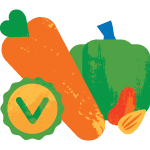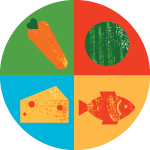What is a Plant-Based Diet?
According to the Heart Foundation, plant-based eating includes a range of eating patterns, from consuming no animal products to including small-to-moderate amounts of animal products. It also doesn’t necessarily mean you are vegetarian or vegan. A ‘plant-based’ or ‘plant-forward’ diet focuses on primarily eating foods from plants. That means fruits and vegetables but also nuts, seeds, whole grains and legumes. Meat and dairy are not automatically excluded from this kind of diet.
Vegan & Vegetarian Diets
According the Health Direct, vegetarians don’t eat meat, poultry or seafood. However, there are different types of vegetarian diets, which we explain further on this page. There are many reasons to try a vegan or vegetarian diet. As stated by The Heart Foundation, “A diet centred on plenty of whole, minimally processed plant foods lowers your risk of heart disease and benefits your overall health”. But what do these diets mean for your shopping list? And which diet will suit your lifestyle? We’ll break down the different plant-based diets and their benefits below.
The Four Types of Plant-Based Diets
There are several different interpretations of a plant-based diet. You don’t necessarily have to adopt a vegetarian or vegan diet to incorporate more plant foods into your diet. You can simply replace processed foods with more fruit and vegetables and reap the health benefits. From fully vegan to the adaptable planetary health diet, there are a wide variety of plant-based diets to dabble in. Read about what each diet involves and see if they sound like something you and your family would like to try.
1. Vegetarian Diet

Similar to veganism, a vegetarian doesn’t eat meat, poultry or fish. A vegetarian diet that does include fish is called a pescetarian diet. The main difference between veganism and vegetarianism is that vegetarians eat dairy and eggs. A well-balanced vegetarian diet can provide you with all the nutrition you need for good health. In place of meat, vegetarians can incorporate high protein products such as tofu, lentils and tempeh into their diet. Check out some of our vegetarian recipes for inspiration.
2. Vegan Diet

A vegan diet excludes any products made from animals. Apart from meat and poultry, animal products also include dairy, eggs, fish and, in some cases, honey. An individual may choose not to eat meat for ethical, environmental or health reasons. They may also choose to incorporate veganism into their everyday life by avoiding clothes made from animal-derived materials and beauty products tested on animals. By eliminating meat and animal products, vegans rely on a range of other foods for nutritional value, like legumes, vegetables and whole grains. You can read more on vegetarian diets by Dietitians Australia. You can check out some of our vegan recipes here.
3. Flexitarian Diet

Don’t worry, this diet does not require any gymnastic ability. But it does have the same amount of flexibility. The flexitarian diet encourages eating mostly plant-based foods, whilst still allowing meat and animal products to be eaten in moderation. For example, you might eat vegetarian meals all week and have spaghetti bolognese on Friday night. It’s all the benefits of a vegetarian diet without cutting out meat altogether.
4. Planetary Health Diet
Not ready to go meat-free? No worries! Much like the flexitarian diet, the Planetary Health Diet* is a flexible option. The Planetary Health Diet is similar to a vegetarian diet but allows more flexibility. In general, it limits meat consumption and encourages more fruit, vegetables, nuts, legumes and whole grains into your week.
According to Eat Forum, the diet provides guidelines to ranges of different food groups that together, constitute the optimal diet for human consumption and environmental sustainability. It emphasises a plant-forward diet where whole grains, fruits, nuts and legumes make up a greater portion of your food consumed. Meat and dairy constitute important part of the diet but in significantly smaller proportions.
The way the Planetary Health Diet works is that you fill half of your plate with vegetables and the other half with a combination of whole grains and proteins (both animal and plant-based). For more information on this, check out the Eat Forums website here.
Health Benefits of a Plant-Based Diet
Now that you know the different types of plant-based diets, let’s get into their benefits1. From a health perspective, there are many perks to making your meals plant-based. Here are a few notable advantages.
- Meat contains saturated fat which can contribute to heart issues if eaten in excess. By having less meat in your diet and eating more anti-inflammatory, plant-based foods like leafy greens, you’re giving your heart some love. To learn more, check out this article from The Heart Foundation.
- Saturated fats also raise cholesterol levels. As plants are lower in saturated fats than animal products, sticking to a plant-based diet can help lower your risk of diabetes.
- Weight loss may be a by-product of nourishing your body with whole grains and vegetables which are relatively low on the glycaemic index (a value used to measure how much specific foods increase blood sugar level).
- If you are cutting down on meat and replacing your source of protein with plant-based foods, the benefits just keep on coming. Increasing your intake of fruits and veggies that are high in antioxidants and fatty acids can help decrease your risk of stroke.
- As well as keeping you physically strong, a plant-based diet can help you stay mentally fit, too. Research has shown that plant-based diets play a role in slowing the progression of Alzheimer’s and dementia.* The likely reason is that polyphenols, which are found in fruits and vegetables, help to reverse cognitive decline.
And if your dishes are feeling boring, check out this database of whole grain registered products at ALDI for more inspo on the types of whole grains you could include. The Planetary Health Diet can be adapted to different dietary requirements and cultural traditions. The reason it’s called the Planetary Health Diet is because you’re packing your plate full of veggies which is great for both you and the planet!
Environmental Benefits of a Plant-Based Diet
Along with the myriad health benefits, it must be noted that there are wonderful environmental benefits to having a plant-based diet. Going vegan or vegetarian stops the deforestation and greenhouse gas emissions associated with meat production. This helps to slow climate change, tackle food insecurity and generally make a good difference to our planet.
For more tips on how you can join ALDI in reducing carbon emissions, check out this article.
Vegan Doesn’t Always Equal Healthy
Remember, just because an item is classified as ‘vegan’, doesn’t automatically make it healthy. For example, hot chips, soft drinks, vegetarian hot dogs and biscuits are all vegan but high in saturated fat, sugar and salt. When shopping, try to avoid overly processed vegan foods and snacks, in the same way you would with non-vegan products. As a rule of thumb, the closer a product is to how it’s found in nature, the healthier it is. This applies to nuts, seeds, fruit, veg and legumes.
If you feel you might need a consultation with a health professional, it is recommended to choose an Accredited Practicing Dietician (APD) who is qualified to offer a wide range of health and nutrition services and advice. According to Dietitians Australia, APD’s are Australia’s most trusted dietetics professionals.
Frequently Asked Questions
What is the difference between vegan and vegetarian?
Whilst both diets exclude meat and poultry, vegans also do not eat any animal products. Along with eggs and dairy, this includes honey and gelatine.
Is a vegan diet healthy?
A vegan diet can be healthy; however, it can lack certain nutrients that you would automatically get in a dairy and meat-eating diet (for example iron and calcium). With some creativity and research, you can find the nutrients you need from plant sources.
Do vegetarians eat fish?
Vegetarians do not eat the flesh of animals and therefore do not eat fish. If you are a vegetarian who does eat fish and seafood, you are classified as a pescatarian.
How do vegans get protein?
Although common, meat and poultry are not the only source of protein on the market. Vegans can get protein from nut butters, grains, legumes, tofu and other non-animal products.
Where did the Planetary Health Diet come from?
The planetary health diet (PHD) was created by EAT-Lancet Commission. Thirty leading scientists from 16 different countries worked together to come up with the plan.